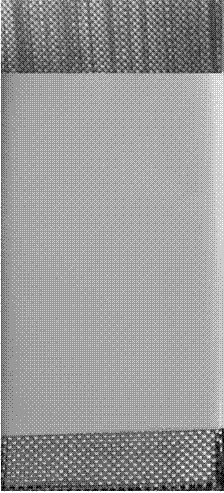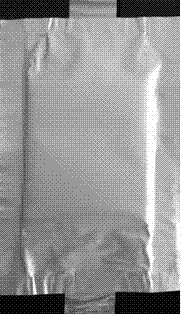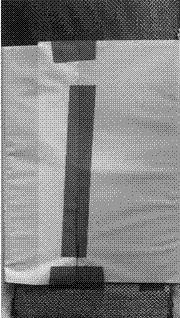Secondary lithium-ion battery with aluminum, nickel, copper and graphite cloth as current collector
A graphite cloth and current collector technology, applied in the field of secondary lithium ion batteries, can solve the problems of huge differences in the electron conduction rate, electron density and uniformity of active materials, and huge differences in electron conduction rate, electron density and uniformity, etc. High-value, capacity-enhancing effects
- Summary
- Abstract
- Description
- Claims
- Application Information
AI Technical Summary
Problems solved by technology
Method used
Image
Examples
Embodiment 1
[0016] Lithium cobaltate and artificial graphite are used as positive and negative electrode active materials, and aluminum-coated graphite cloth (graphite cloth thickness 140µm aluminum coating thickness 1µm) and nickel-plated graphite cloth (graphite cloth thickness 180µm nickel coating thickness 3µm) are used as positive and negative electrode current collectors ; The battery structure is laminated. Add the positive electrode active material, 5% binder PVDF, and 5% conductive agent VGCF into NMP (nitrogen methyl pyrrolidone) in proportion; add the negative electrode active material, 5% binder PVDF, and 3% conductive agent VGCF by Add NMP (Nitromethylpyrrolidone) in proportion, stir it into a homogeneous mixture, apply it to aluminum-plated and nickel-plated graphite cloth positive and negative current collectors on both sides, soak for a period of time, vacuum dry and electrode press, and then cut into pieces for later use. Alternately overlap and arrange the positive and n...
Embodiment 2
[0020] Lithium manganate and lithium titanate are used as positive and negative electrode active materials, and aluminum-coated graphite cloth (graphite cloth thickness 200µm, aluminum coating thickness 4µm) and nickel-plated graphite cloth (graphite cloth thickness 250µm, nickel coating thickness 7µm) are used as positive and negative electrode collectors. Fluid; the battery structure is laminated. The preparation method of the pole piece and the battery and the preparation of the comparative battery are the same as those described in Example 1.
[0021] The comparative lithium ion battery prepared in the above manner has a design capacity of 2000mAh. The voltage of the battery using aluminum-plated and nickel-plated graphite cloth as the positive and negative current collectors is 2.5V, the first discharge capacity is 1960mAh, and the capacity retention rate after 50 cycles is 92%. The first discharge capacity of the battery using traditional metal foil as the positive and ...
Embodiment 3
[0023] Use ternary materials and silicon-carbon composite materials as positive and negative electrode active materials, and use aluminum-coated graphite cloth (graphite cloth thickness 270µm aluminum coating thickness 5µm) and nickel-plated graphite cloth (graphite cloth thickness 300µm nickel coating thickness 10µm) as positive and negative electrodes Current collector; battery structure is laminated. The preparation method of the pole piece and the battery and the preparation of the comparative battery are the same as those described in Example 1.
[0024] The comparative lithium ion battery prepared in the above manner has a design capacity of 2000mAh. The voltage of the battery using aluminum-plated and nickel-plated graphite cloth as the positive and negative electrode collectors is 3.5V, the first discharge capacity is 1954mAh, and the capacity retention rate after 50 cycles is 95%, that is, 1885mAh, while the traditional metal foil is used as the positive and negative ...
PUM
| Property | Measurement | Unit |
|---|---|---|
| thickness | aaaaa | aaaaa |
| thickness | aaaaa | aaaaa |
| thickness | aaaaa | aaaaa |
Abstract
Description
Claims
Application Information
 Login to View More
Login to View More - R&D
- Intellectual Property
- Life Sciences
- Materials
- Tech Scout
- Unparalleled Data Quality
- Higher Quality Content
- 60% Fewer Hallucinations
Browse by: Latest US Patents, China's latest patents, Technical Efficacy Thesaurus, Application Domain, Technology Topic, Popular Technical Reports.
© 2025 PatSnap. All rights reserved.Legal|Privacy policy|Modern Slavery Act Transparency Statement|Sitemap|About US| Contact US: help@patsnap.com



